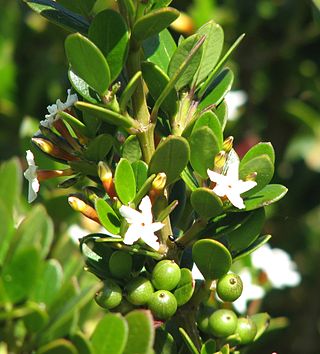
Alyxia is an Australasian genus of flowering plant in the dogbane family, Apocynaceae. It contains at present 106 species, but Alyxia stellata and A. tisserantii are very variable, might be cryptic species complexes, and are need of further study. It consists of shrubby, climbing or scrambling plants. This genus occurs in China, the Himalayas, Southeast Asia, Australia, New Caledonia and the Pacific Islands. There are 14 species in Australia, 21 in New Caledonia and 7 in the other Pacific Islands, including Hawaiʻi.
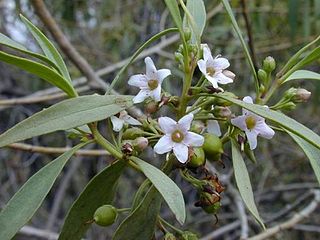
Myoporum is a genus of flowering plants in the figwort family, Scrophulariaceae. There are 30 species in the genus, eighteen of which are endemic to Australia although others are endemic to Pacific Islands, including New Zealand, and one is endemic to two Indian Ocean islands. They are shrubs or small trees with leaves that are arranged alternately and have white, occasionally pink flowers and a fruit that is a drupe.

Fontainea is a genus constituting part of the plant family Euphorbiaceae. The nine currently known species grow naturally in Queensland (Qld) and New South Wales (NSW) Australia, New Caledonia and Vanuatu, and Papua New Guinea. Some species are commonly named blushwood.

Cordyline is a genus of about 24 species of woody monocotyledonous flowering plants in family Asparagaceae, subfamily Lomandroideae. The subfamily has previously been treated as a separate family Laxmanniaceae, or Lomandraceae. Other authors have placed the genus in the Agavaceae. Cordyline is native to the western Pacific Ocean region, from New Zealand, eastern Australia, southeastern Asia and Polynesia, with one species found in southeastern South America.

Microtis, commonly known as onion orchids or mignonette orchids is a genus of about 20 species of plants in the orchid family, Orchidaceae. Onion orchids are terrestrial herbs with a single leaf at the base of the plant. They are similar to orchids in the genus Prasophyllum in that they have an onion-like leaf. The flowers are small but often scented and attractive to their insect pollinators. They are widespread in Asia, Australia and some Pacific islands.

Schefflera is a genus of flowering plants in the family Araliaceae with 13 species native to New Zealand and some Pacific islands.

Ripogonum is a genus of flowering plants confined to eastern Australia, New Zealand, and New Guinea. Until recently this genus was included in the family Smilacaceae, and earlier in the family Liliaceae, but it has now been separated as its own family Ripogonaceae.
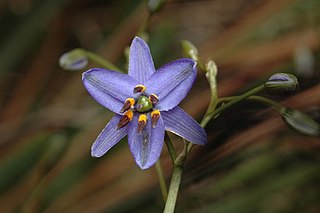
Dianella is a genus of about forty species of flowering plants in the monocot family Asphodelaceae, commonly known as flax lilies. Plants in this genus are tufted herbs with more or less linear leaves and bisexual flowers with three sepals more or less similar to three petals and a superior ovary, the fruit a berry. They occur in Africa, South-east Asia, the Pacific Islands, New Zealand and Australia.

Geniostoma is a genus of around 49 species of flowering plants in the family Loganiaceae. They are shrubs or small trees, with inflorescences borne in the axils of the simple, petiolate, oppositely-arranged leaves. The flowers are arranged in cymes, and each is pentamerous.

Melodinus is a genus of plant in the family Apocynaceae, first described as a genus in 1776. It is native to Indomalaya, Meganesia and various islands in the western Pacific. A type of monoterpenoid indole alkaloids called melodinines can be isolated from Melodinus plants.

Dipodium, commonly known as hyacinth orchids, is a genus of about forty species of orchids native to tropical, subtropical and temperate regions of south-east Asia, New Guinea, the Pacific Islands and Australia. It includes both terrestrial and climbing species, some with leaves and some leafless, but all with large, often colourful flowers on tall flowering stems. It is the only genus of its alliance, Dipodium.

Dipodium punctatum, commonly known as the blotched hyacinth-orchid, is a leafless orchid that is a native to eastern and south-eastern continental Australia. In summer it produces a tall flowering stem with up to sixty pale to bright pink flowers with heavy red blotches. A widespread and common species it is often confused with D. roseum and some authorities regard it as a synonym of D. squamatum.

Parsonsia is a genus of woody vines in the family Apocynaceae. Species occur throughout Indomalaya, Australasia and Melanesia.

Gahnia is a genus of sedges native to China, Southeast Asia, New Guinea, Australia, New Zealand and a number of Pacific Islands. The common name is due to the toothed margins. It often forms tussocks.

Olea paniculata, commonly known as the native olive, is a plant of the genus Olea and a relative of the olive. It grows natively in Pakistan and southwestern China (Yunnan) through tropical Asia to Australia and the Pacific islands of New Caledonia, Vanuatu and Lord Howe Island.

Astelia is a genus of flowering plants in the recently named family Asteliaceae. They are rhizomatous tufted perennials native to various islands in the Pacific, Indian, and South Atlantic Oceans, as well as to Australia and to the southernmost tip of South America. A significant number of the known species are endemic to New Zealand. The species generally grow in forests, swamps and amongst low alpine vegetation; occasionally they are epiphytic.
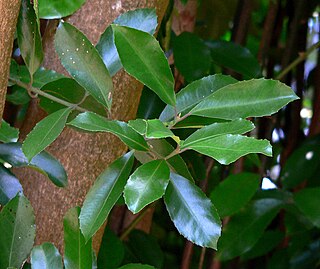
Hedycarya is a genus of about 16 species of flowering plants in the family Monimiaceae native to eastern Australia, New Zealand, and some Pacific Islands. Plants in the genus Hedycarya are shrubs, or small to medium trees with sometimes toothed leaves. The male and female flowers cup-shaped and are borne on separate plants. Male flowers usually have 8 tepals and many stamens and female flowers are have 6 to 12 tepals with many carpels. The fruit is a cluster of drupes.
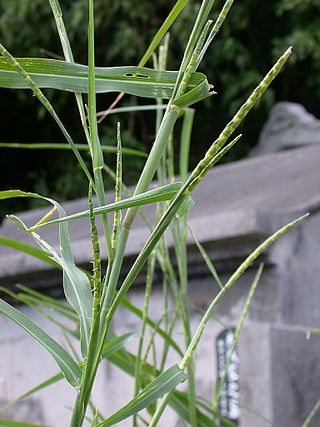
Rottboellia is a genus of African, Asian, and Australian plants in the grass family.

Corynocarpus is the only genus of plants in the family Corynocarpaceae and includes five species. It is native to New Guinea, Australia, New Zealand, New Caledonia, and Vanuatu.
Paul Irwin Forster is an Australian botanist. He obtained his doctorate from the University of Queensland in 2004 with his thesis The pursuit of plants : studies on the systematics, ecology and chemistry of the vascular flora of Australia and related regions.


















